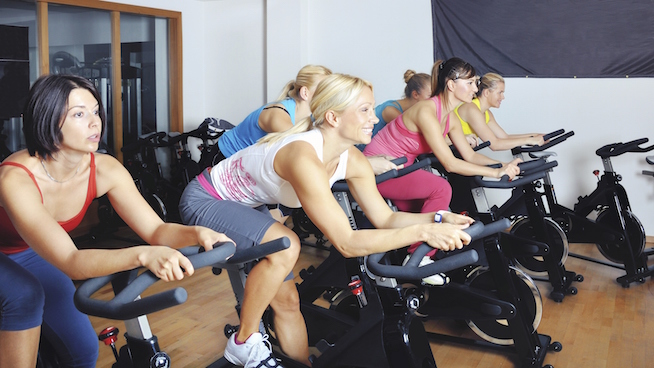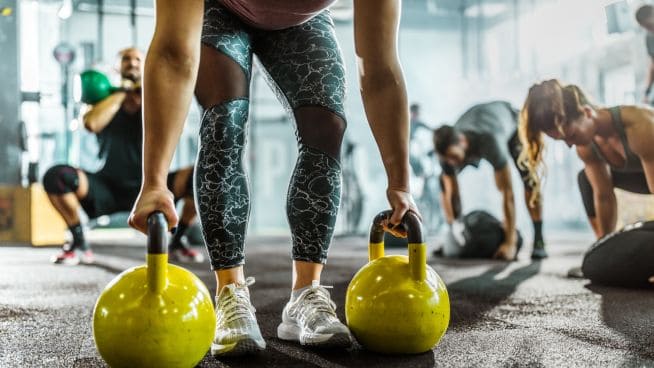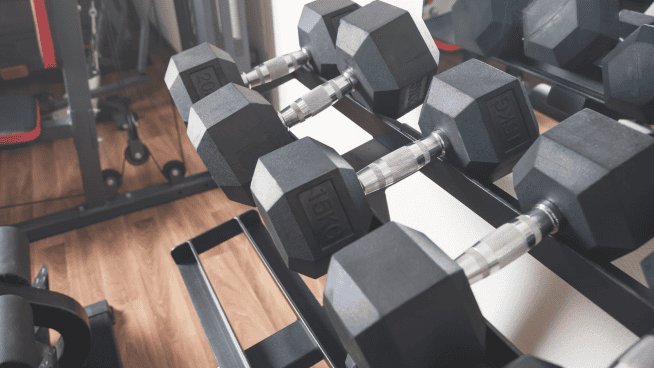Indoor Cycling Probably Won’t Make You Fit. Here’s Why.
Indoor cycling is tough. After an hour of pedaling at high speed, you’ve probably left a puddle of sweat on the floor under your bike.
Indoor cycling seems more popular than ever. Boutique indoor cycling studios are popping up all over the country, drawing in a new breed of people looking to burn fat and improve their fitness. The classes are fun, and the routines can easily lead to the assumption that participants get a great workout.
But is that actually the case?
According to Brian Nguyen, owner of Brik Fitness (Redondo Beach, California) and trainer to Mark Wahlberg, indoor cycling might not be what it’s all cracked up to be.
“I consider Brik Fitness a fat loss center,” he says. “How many cycles will you find in my gym? Zero.”
Indoor Cycling is Similar to Jogging
In some training circles, jogging is perceived as the holy grail of weight loss. That’s why you see hordes of people jogging along the streets in the morning and after work or school. “A huge percentage of people believe that cardio is the tool you need to burn fat,” adds Nguyen.
Indoor cycling produces similar effects in the body as jogging. They are both aerobic activities. Your body uses oxygen to create a source of energy for long-duration, moderate-pace activity. As you cycle for 60 or so minutes, your body burns calories to keep your legs churning.
It is possible to shed fat if the number of calories you burn in a day, including while indoor cycling, totals less than the number you consume. However, many factors go into this, including your resting metabolic rate (i.e., how many calories your body burns for essential functions, like breathing), your daily activity, the intensity of your cycling class and your diet.
Unfortunately, the weight-loss benefits stop there.
Once you finish a cycling class, your body no longer burns calories. “Your body says to itself, ‘Well I worked hard, but now I just need to rest,’” Nguyen says. “Your lungs will have more aerobic capacity, but that’s about it.”
If you were to perform an intense 4-minute Tabata routine, your body would continue to burn extra calories. That’s because the high-intensity work places your body in oxygen debt, forcing it to work to recover, even after you finish. This is why when Nguyen explains the fat-burning process to new clients, he says you actually lose fat when you’re at home or at night, not when you’re actually working out.
Yes, you may sweat profusely during a indoor cycling class, but that doesn’t mean you’re working at the intensity level you need for this bonus calorie burn. It’s impossible to maintain a near-max-effort activity for 60 minutes. Try doing Burpees for one minute straight and see how you feel.
This is the logic behind intervals, which call for brief bouts of max-effort exercise followed by short periods of rest. Watch the video above for an example of an interval workout that burns fat.
Indoor Cycling Doesn’t Build Muscle
When you first start cycling, you might see some initial improvement—especially if you don’t work out much. But that’s as far as it will likely take you. “After about two weeks, your body will be adapted, and you won’t add any muscle mass,” Nguyen says.
According to Nguyen, your muscles are like a car engine. The larger the engine, the more fuel it will burn. Or in this case, the more muscle mass you have, the more calories you will use. With cycling, your engine never gets bigger. In some cases, you might actually lose muscle mass. Nguyen explains: “Cycling never makes your body gain lean body mass, and that’s the thing that burns fat. At the end of the day, metabolism isn’t improved on a bike.” Your results depend completely on how many calories you burn when you cycle, not on long-term changes in your body composition.
Your legs might burn during a indoor cycling class, but that’s not causing muscle growth. It might hurt a little bit, but you can do it over and over again, because you’re working against minimal resistance. It’s like trying to add muscle by doing 10 sets of a 100 reps, which is something you’ll never hear recommended by a strength coach.
The body needs to create force and overcome stress to adapt and create muscle. For example, you might do three sets of 10 reps of a strength exercise using a challenging weight, one that allows you to have two reps left in the tank at the end of each set. Nguyen says, “This is the simplest way to create lean muscle mass, which is the true measure for fat loss. If lean mass increases, your engine will get bigger and burn more fuel throughout the day.”
RELATED: 5 Reasons You Can’t Build Muscle
Indoor Cycling Is Not Progressive
The key to a successful workout program is progression. The difficulty of a workout must increase as you get stronger and more fit. The best example of this is when you gradually increase the amount of weight you lift in an exercise. No one wants to lift the same weight over and over again.
Indoor Cycling does not involve individual progression.
You’re in a class of 15 to 20 people. The coach takes the group through a routine consisting of steady rides, fast sprints and grinding hills. While it’s challenging, no attention is paid to your individual needs and progress.
Let’s say you crushed one area of the ride last week. Did you mark it down? If so, did you make a concerted effort to ride harder in that segment this week? Did the coach note your progress and encourage you to pedal faster or use greater resistance? Odds are, the answers are “No.” And that’s why results often plateau.
“When you go into a cycle class, it’s not about your goals. You’re just following the group, making it tough to really understand how you’re improving,” Nguyen says. “When the body goes through too much cycling and gets used to the motions, there’s no more chaos. Progress is made at the edge of chaos.”
In addition, Nguyen says there’s limited accountability when you’re on the bike. It’s easy to see when you add weight to a strength exercise or you can do more reps. Cycling relies on perceived effort and turning a dial to adjust the bike’s resistance.
What you “feel” as the correct perceived effort may not necessarily be the intensity you should be working at. And no one is there to check if you’re actually increasing the resistance like the coach is telling you to. Let’s be honest: some people don’t increase the resistance as much as they should.
Indoor Cyling Reinforces Common Injury Issues
Our day-to-day habits take a toll on our bodies. Sitting down too much creates tight hip flexors, poor posture and ultimately, back pain. Not to mention the havoc that looking down at our smartphones does to our posture.
Rather than correcting these problems, cycling actually exacerbates them.
Nguyen points out that when you cycle, you are actually sitting. “If someone has tight hip flexors because they sit too much, does it make sense to have them sit more?” he asks “Or if someone has back pain, are you going to have them sit down and flex their back again?”
Cycling does involve an extension of the knee and hip, but not through a complete range of motion. Also, the core is hardly engaged during indoor cycling. It’s purely a lower-body movement—which is why you feel your quads burn. So realistically, you’re not getting the complete workout you need to strengthen and maintain your body.
“People have goals to lose fat and improve their core and posture,” Nguyen says. “Sitting down again for a workout after you sit down all day is not the best choice.”
Instead, it’s better to perform strength exercises through a full range of motion to develop strength, improve mobility and correct postural imbalances.
WATCH: Simple Strategies to Fix Back Pain
Should You Never Indoor Cycle Again?
A lot of people enjoy indoor cycling, and that’s OK. Some of you may have even seen solid results with indoor cycling. When it all comes down to it, you need to find what works for you.
However, we encourage you to use indoor cycling as a supplement to a workout program, not as the primary focus. Nguyen recommends doing three to four intense strength workouts each week before considering extra endurance work like indoor cycling.
When combined with strength training, indoor cycling may give you that extra calorie burn you need to accelerate fat loss. When done on its own, your results from indoor cycling will likely fall short of your expectations.
RECOMMENDED FOR YOU
MOST POPULAR
Indoor Cycling Probably Won’t Make You Fit. Here’s Why.
Indoor cycling is tough. After an hour of pedaling at high speed, you’ve probably left a puddle of sweat on the floor under your bike.
Indoor cycling seems more popular than ever. Boutique indoor cycling studios are popping up all over the country, drawing in a new breed of people looking to burn fat and improve their fitness. The classes are fun, and the routines can easily lead to the assumption that participants get a great workout.
But is that actually the case?
According to Brian Nguyen, owner of Brik Fitness (Redondo Beach, California) and trainer to Mark Wahlberg, indoor cycling might not be what it’s all cracked up to be.
“I consider Brik Fitness a fat loss center,” he says. “How many cycles will you find in my gym? Zero.”
Indoor Cycling is Similar to Jogging
In some training circles, jogging is perceived as the holy grail of weight loss. That’s why you see hordes of people jogging along the streets in the morning and after work or school. “A huge percentage of people believe that cardio is the tool you need to burn fat,” adds Nguyen.
Indoor cycling produces similar effects in the body as jogging. They are both aerobic activities. Your body uses oxygen to create a source of energy for long-duration, moderate-pace activity. As you cycle for 60 or so minutes, your body burns calories to keep your legs churning.
It is possible to shed fat if the number of calories you burn in a day, including while indoor cycling, totals less than the number you consume. However, many factors go into this, including your resting metabolic rate (i.e., how many calories your body burns for essential functions, like breathing), your daily activity, the intensity of your cycling class and your diet.
Unfortunately, the weight-loss benefits stop there.
Once you finish a cycling class, your body no longer burns calories. “Your body says to itself, ‘Well I worked hard, but now I just need to rest,’” Nguyen says. “Your lungs will have more aerobic capacity, but that’s about it.”
If you were to perform an intense 4-minute Tabata routine, your body would continue to burn extra calories. That’s because the high-intensity work places your body in oxygen debt, forcing it to work to recover, even after you finish. This is why when Nguyen explains the fat-burning process to new clients, he says you actually lose fat when you’re at home or at night, not when you’re actually working out.
Yes, you may sweat profusely during a indoor cycling class, but that doesn’t mean you’re working at the intensity level you need for this bonus calorie burn. It’s impossible to maintain a near-max-effort activity for 60 minutes. Try doing Burpees for one minute straight and see how you feel.
This is the logic behind intervals, which call for brief bouts of max-effort exercise followed by short periods of rest. Watch the video above for an example of an interval workout that burns fat.
Indoor Cycling Doesn’t Build Muscle
When you first start cycling, you might see some initial improvement—especially if you don’t work out much. But that’s as far as it will likely take you. “After about two weeks, your body will be adapted, and you won’t add any muscle mass,” Nguyen says.
According to Nguyen, your muscles are like a car engine. The larger the engine, the more fuel it will burn. Or in this case, the more muscle mass you have, the more calories you will use. With cycling, your engine never gets bigger. In some cases, you might actually lose muscle mass. Nguyen explains: “Cycling never makes your body gain lean body mass, and that’s the thing that burns fat. At the end of the day, metabolism isn’t improved on a bike.” Your results depend completely on how many calories you burn when you cycle, not on long-term changes in your body composition.
Your legs might burn during a indoor cycling class, but that’s not causing muscle growth. It might hurt a little bit, but you can do it over and over again, because you’re working against minimal resistance. It’s like trying to add muscle by doing 10 sets of a 100 reps, which is something you’ll never hear recommended by a strength coach.
The body needs to create force and overcome stress to adapt and create muscle. For example, you might do three sets of 10 reps of a strength exercise using a challenging weight, one that allows you to have two reps left in the tank at the end of each set. Nguyen says, “This is the simplest way to create lean muscle mass, which is the true measure for fat loss. If lean mass increases, your engine will get bigger and burn more fuel throughout the day.”
RELATED: 5 Reasons You Can’t Build Muscle
Indoor Cycling Is Not Progressive
The key to a successful workout program is progression. The difficulty of a workout must increase as you get stronger and more fit. The best example of this is when you gradually increase the amount of weight you lift in an exercise. No one wants to lift the same weight over and over again.
Indoor Cycling does not involve individual progression.
You’re in a class of 15 to 20 people. The coach takes the group through a routine consisting of steady rides, fast sprints and grinding hills. While it’s challenging, no attention is paid to your individual needs and progress.
Let’s say you crushed one area of the ride last week. Did you mark it down? If so, did you make a concerted effort to ride harder in that segment this week? Did the coach note your progress and encourage you to pedal faster or use greater resistance? Odds are, the answers are “No.” And that’s why results often plateau.
“When you go into a cycle class, it’s not about your goals. You’re just following the group, making it tough to really understand how you’re improving,” Nguyen says. “When the body goes through too much cycling and gets used to the motions, there’s no more chaos. Progress is made at the edge of chaos.”
In addition, Nguyen says there’s limited accountability when you’re on the bike. It’s easy to see when you add weight to a strength exercise or you can do more reps. Cycling relies on perceived effort and turning a dial to adjust the bike’s resistance.
What you “feel” as the correct perceived effort may not necessarily be the intensity you should be working at. And no one is there to check if you’re actually increasing the resistance like the coach is telling you to. Let’s be honest: some people don’t increase the resistance as much as they should.
Indoor Cyling Reinforces Common Injury Issues
Our day-to-day habits take a toll on our bodies. Sitting down too much creates tight hip flexors, poor posture and ultimately, back pain. Not to mention the havoc that looking down at our smartphones does to our posture.
Rather than correcting these problems, cycling actually exacerbates them.
Nguyen points out that when you cycle, you are actually sitting. “If someone has tight hip flexors because they sit too much, does it make sense to have them sit more?” he asks “Or if someone has back pain, are you going to have them sit down and flex their back again?”
Cycling does involve an extension of the knee and hip, but not through a complete range of motion. Also, the core is hardly engaged during indoor cycling. It’s purely a lower-body movement—which is why you feel your quads burn. So realistically, you’re not getting the complete workout you need to strengthen and maintain your body.
“People have goals to lose fat and improve their core and posture,” Nguyen says. “Sitting down again for a workout after you sit down all day is not the best choice.”
Instead, it’s better to perform strength exercises through a full range of motion to develop strength, improve mobility and correct postural imbalances.
WATCH: Simple Strategies to Fix Back Pain
Should You Never Indoor Cycle Again?
A lot of people enjoy indoor cycling, and that’s OK. Some of you may have even seen solid results with indoor cycling. When it all comes down to it, you need to find what works for you.
However, we encourage you to use indoor cycling as a supplement to a workout program, not as the primary focus. Nguyen recommends doing three to four intense strength workouts each week before considering extra endurance work like indoor cycling.
When combined with strength training, indoor cycling may give you that extra calorie burn you need to accelerate fat loss. When done on its own, your results from indoor cycling will likely fall short of your expectations.

















